Marrakech.
The ultimate travel guide to Morocco’s fabled pink city.
Few places conjure the exotic image of Marrakech. A picture, whether you’ve been there or not, of date palms against thousand-year-old ramparts and the Atlas Mountains along the horizon. The frenzy of the medina. Otherworldly calls to prayer. The name alone rolls off the tongue like a siren’s song, enticing a century of travellers from Colette to Winston Churchill, Mick Jagger and Yves Saint Laurent.
Morocco just overtook Egypt as the most visited country on the African continent, but even Ryanair’s daily poundings can’t dampen the mystique of Marrakech. Where else can you breakfast under the scented canopy of orange blossom, wander a medieval souk, sip mint tea with Berber merchants and then retreat to the riad for a cooling dip in the pool—refreshed for sunset, the rooftop and a martini, followed by the perfect tagine?
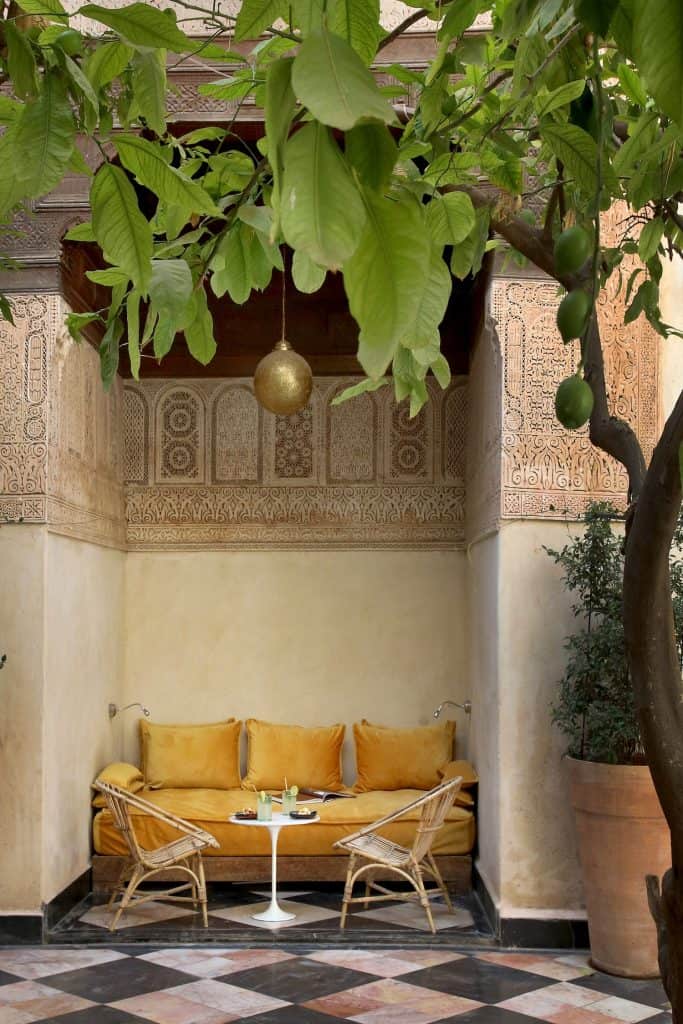
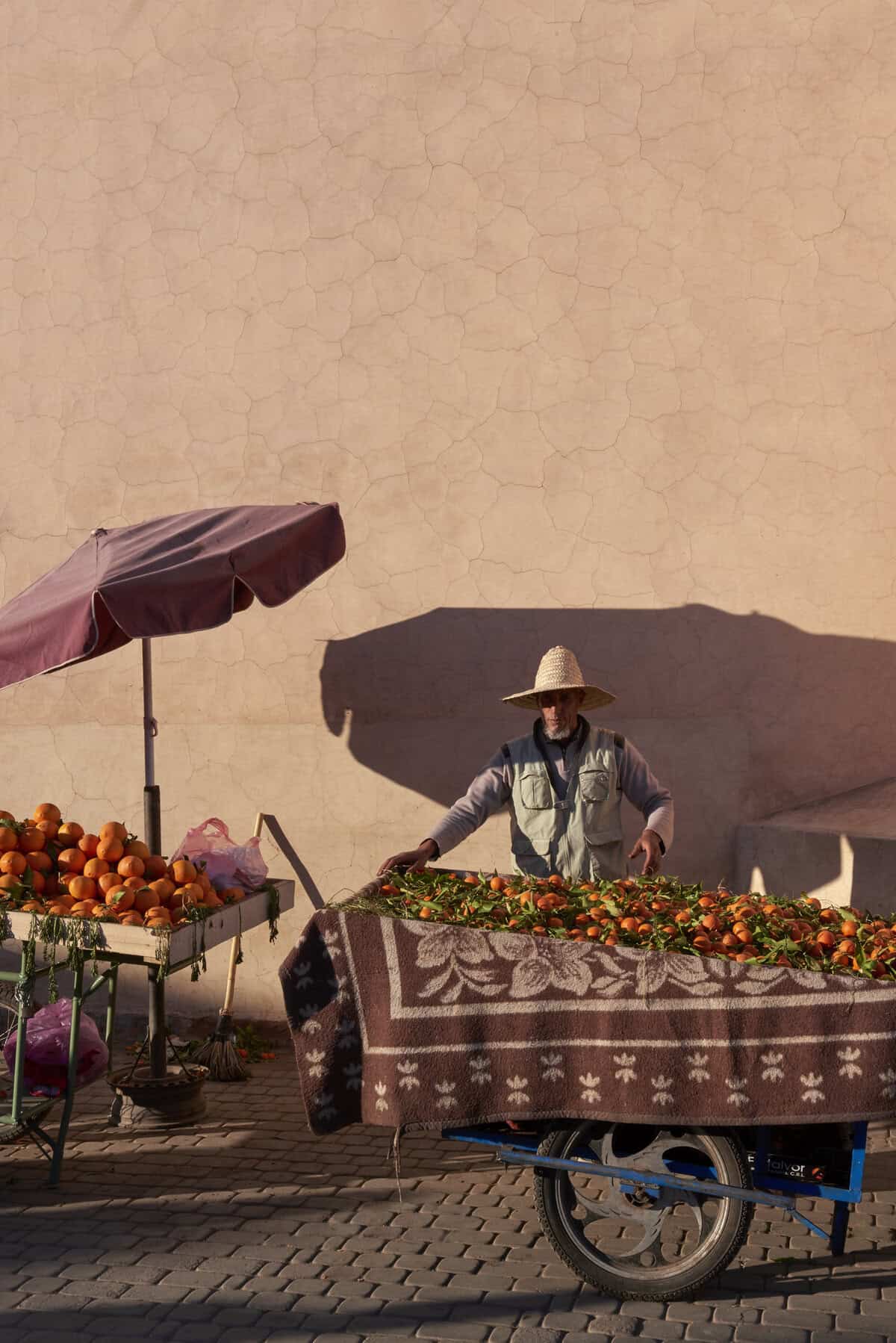
My first trip to Marrakech was in 2000, when the airport was tiny, Jean Paul Gaultier had a house in the medina and Amanjena had just opened outside the city. Smart shops and restaurants were few and far between. Not that it mattered—the town was utter magic.
I returned a couple of months ago, the first time in a decade. Cultural wonders such as Le Jardin Secret, Dar El Bacha and Musée Yves Saint Laurent have opened their doors, while the 16th-century Madrasa Ben Yousef has undergone a top-to-toe restoration. Boutiques, bars and restaurants in the medina and Gueliz—the new town laid out during the French Protectorate, 1912 to 1956—now rival the hotspots of Europe. The souk’s more illustrious merchants have relocated to showrooms in Sidi Ghanem, a burgeoning hub of creativity on the outskirts of town. Hundreds of riads, the traditional Moroccan residential compounds known for their enclosed gardens, have been converted to guesthouses and hotels.
Despite the polish—and the occasional buttressed wall, the region having just endured an earthquake—old Marrakech is still there: the souk as theatrical as ever, magic around each corner of the medina and the dust-pink profile of ramparts against that Majorelle-blue sky.
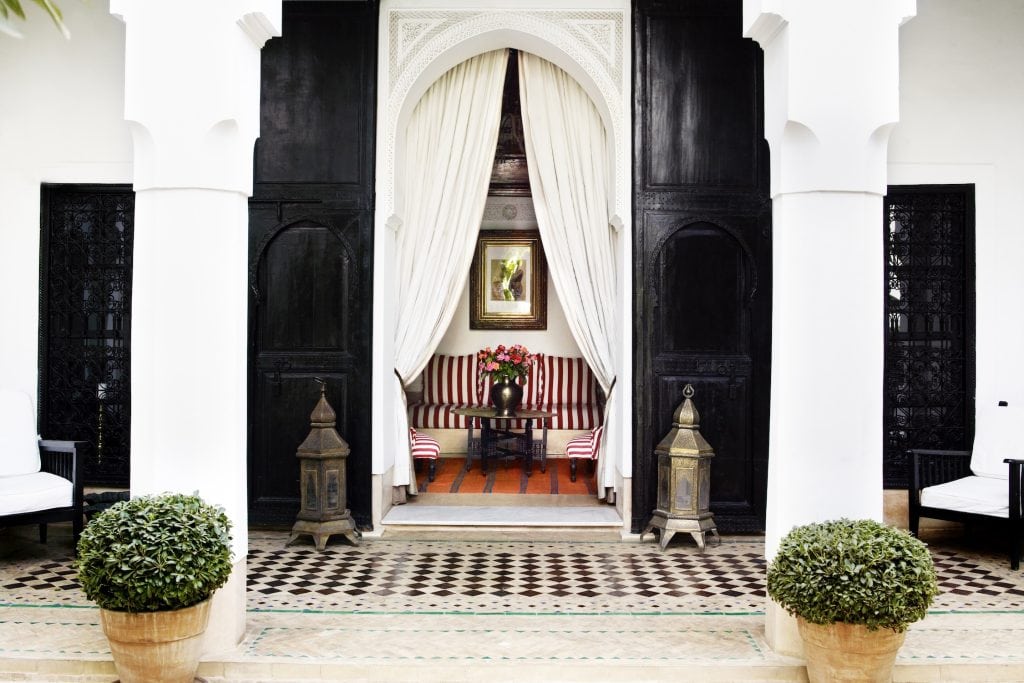
STAY
L’Hotel Marrakech.
They say fashion designers make the best interior designers, but who knew they also make the best hoteliers. Having dressed princesses, ballet dancers and a good chunk of the British public, in 2016 Jasper Conran unveiled his first hotel, having transformed the core of a former Caïdal palace into the town’s most beautiful riad, L’Hotel Marrakech.
The feel is more home than hotel, as if a grand friend with great taste said, have my place for the weekend, excellent staff and all. Syrian chests and life-size portraits of maharajas give L’Hotel an air of travelled opulence, relaxed with striped kilims, white slipcovered sofas and miles of muslin forming four-poster beds. Six suites take the names of Moroccan cities—Zagora, Fez, Agadir—with even the smallest, Tangier, at least twice the size of the average room in the medina.
Palms, citrus, jasmine, Mexican honeysuckle, bougainvillea, Boston ferns and yucca wrap around a saltwater lap pool in the courtyard, accompanied by a cacophony of birdsong, thanks to resident buntings and sparrows. A chic sitting room that converts to a candlelit dining space in the evening and a bar straight out of an Agatha Christie novel complete the ground floor. Upstairs, a verdant, sunset-perfect roof terrace is large enough to not run into other guests. As lovely is the service from the tight-knit team. Breakfast at 3pm? No problem—as if a grand friend with great taste said, have my place for the weekend, excellent staff and all.
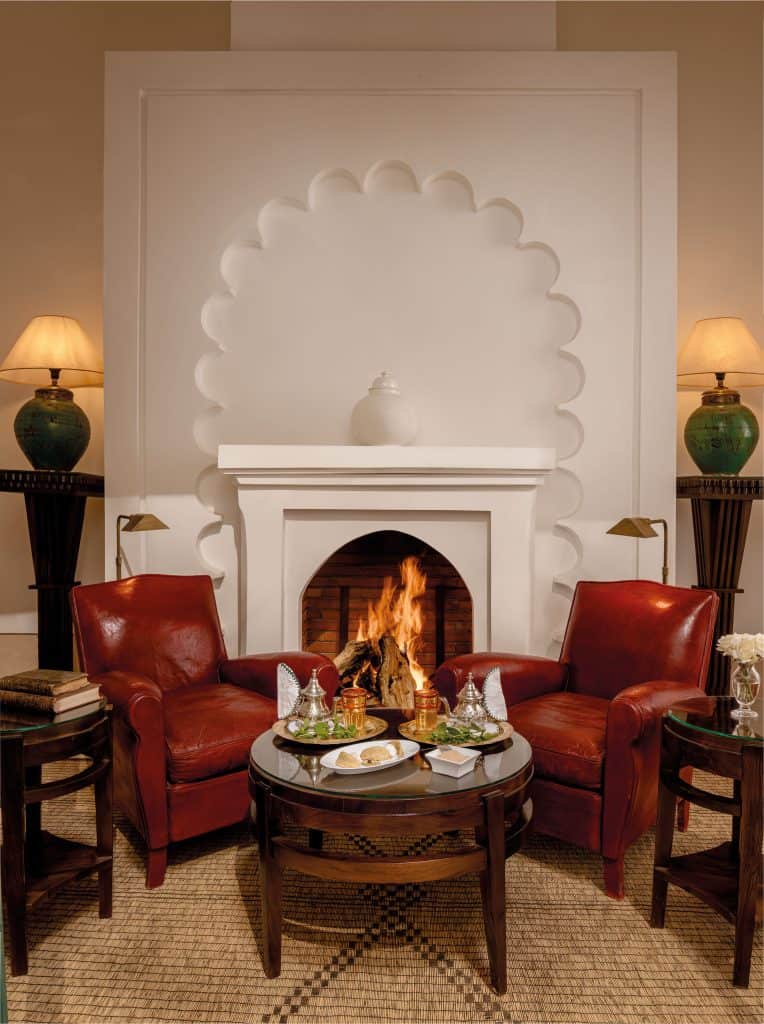
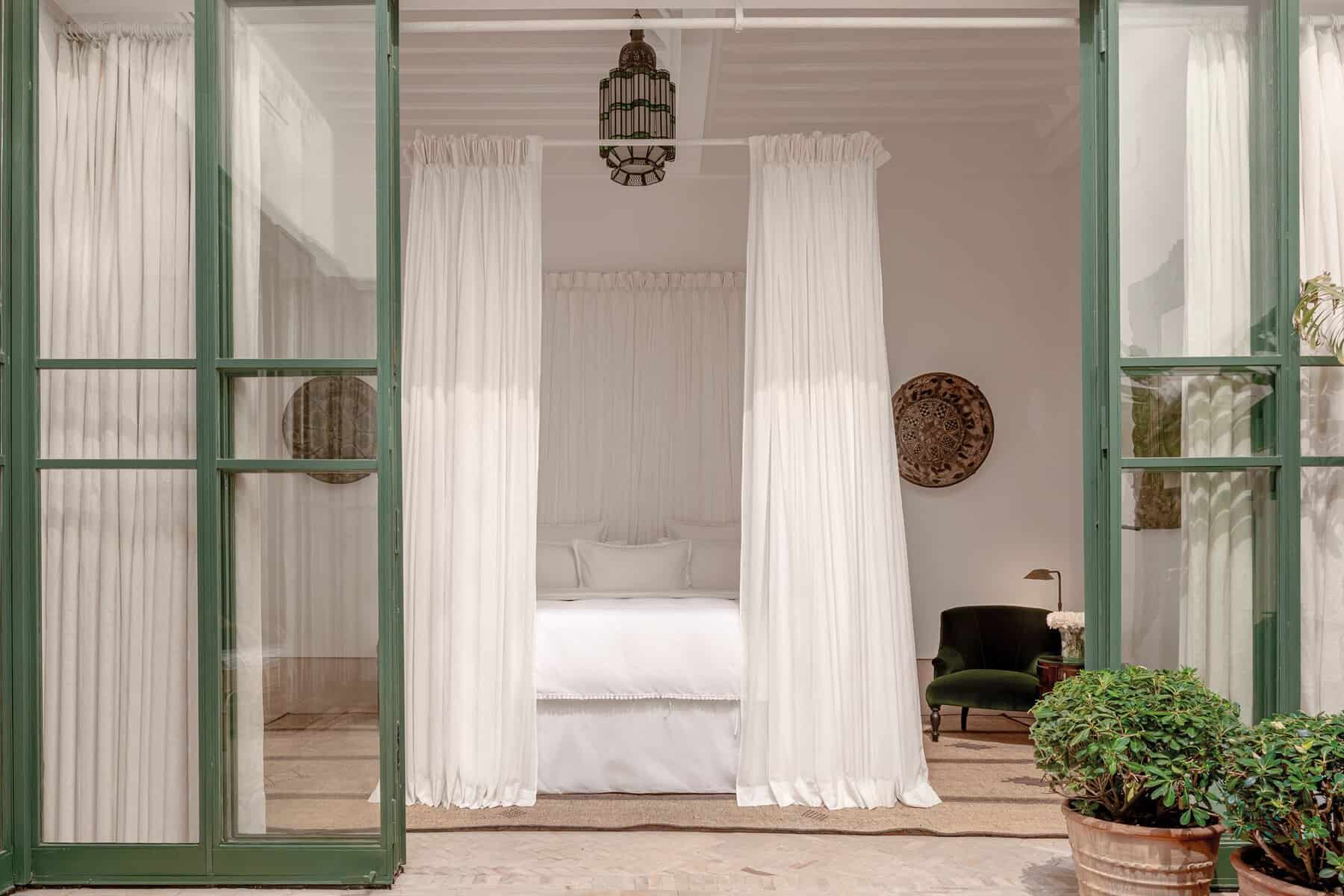
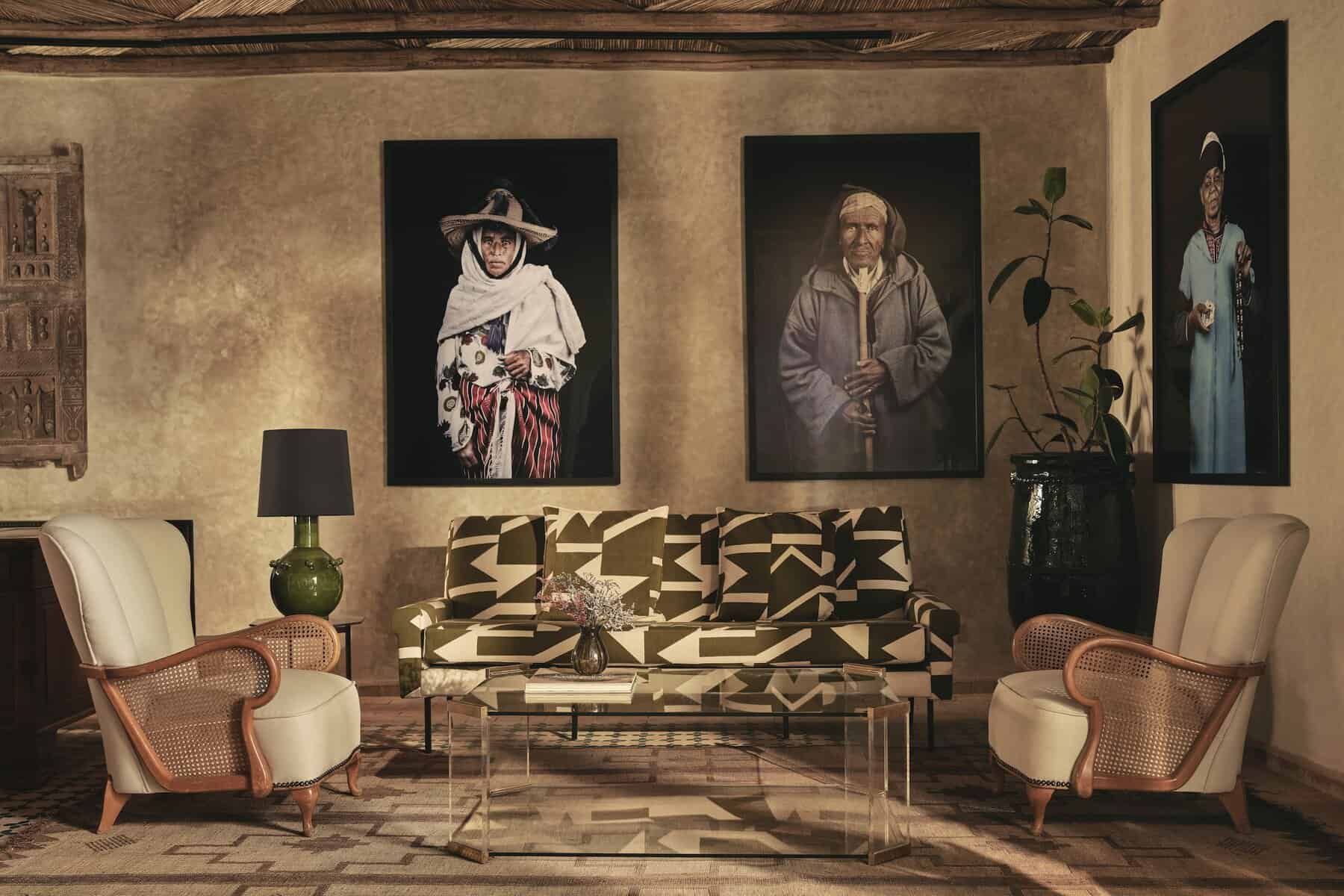
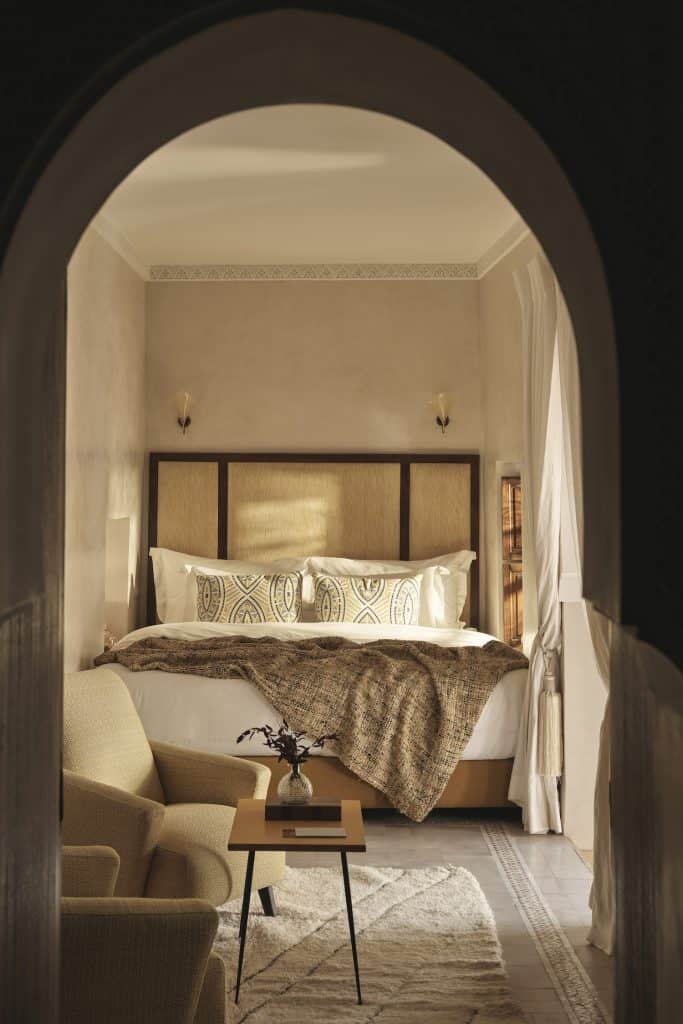
IZZA.
Everyone in Marrakech is talking about IZZA. And with good reason: the city’s latest hotel doubles as a museum of contemporary art, home to a cutting-edge $10-million collection.
Comprising two riads and a modernist extension, the property channels the spirit of Bill Willis, the party-loving American designer who travelled to Marrakech for the wedding of Paul and Talitha Getty in 1966 and never left. Fourteen luxurious guestrooms take the names of personalities who gave the place its bohemian glamour—Cristina (Alaoui), Paul (Bowles), Yves (Saint Laurent)—alongside Izza, the Berber woman who once lived on the site.
Anchoring the lot is 300+ paintings, photographs and NFTs, from Leila Alaoui’s haunting photographic series, ‘Les Marocains’ to motion portraits by the Ethiopian collective, Yatreda. Shared spaces meander throughout, from a cosy library to spa with excellent hammam and state-of-the-art gym—a rarity in a riad—amongst pretty courtyards, one home to a green-tiled lap pool.
Bill’s Bar sports a salon hang of framed Willis memorabilia after IZZA’s owner, British entrepreneur Neil Hutchinson, bought the designer’s former home and discovered an abandoned suitcase stuffed with old photos, letters and the like. Head to the rooftop bar for an Americano, followed by delicious pan-roasted shrimps with garlic, harissa and citrus caviar at in-house restaurant Noujoum—striking works by Brazilian photographer Sebastiao Salgado above olive-green banquettes.
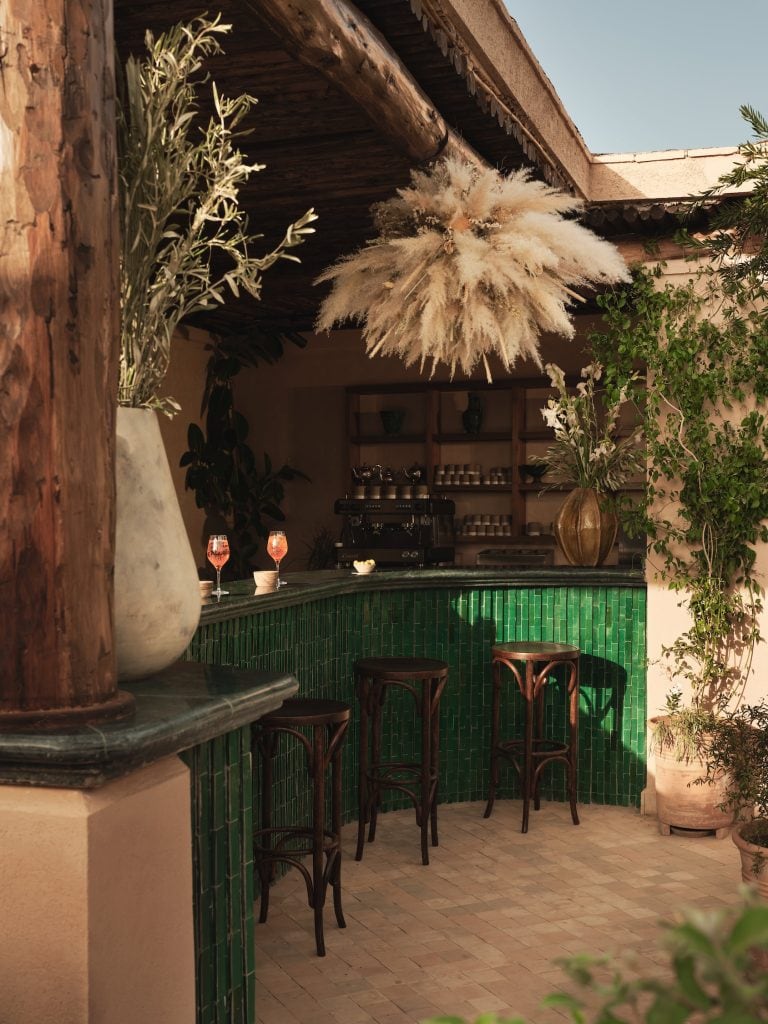
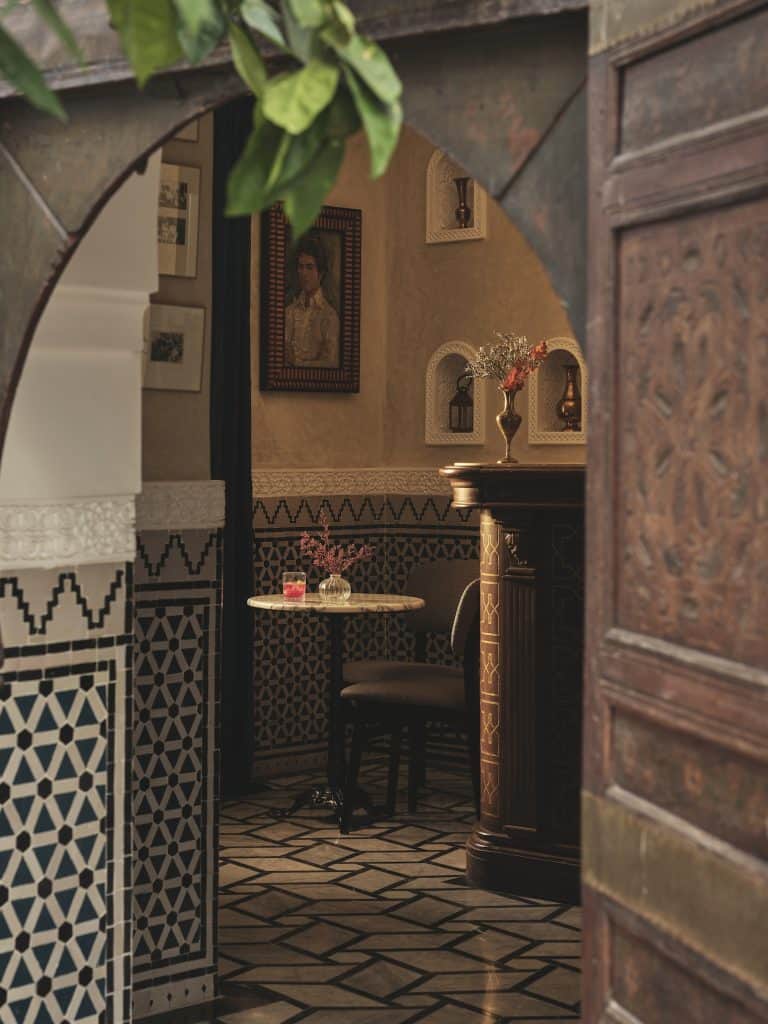

Riad UP.
Riad UP is that place you want to keep secret so it’s always there, just for you, unchanged. Perched in a quiet corner of Kennaria—close but not too close to the action of Jemaa el-Fnaa—this has been a home-away-from-home since 2005, when I would travel to Marrakech to buy Berber rugs and textiles. You don’t know heaven until you’ve spent a day bartering in the souk and returned to UP for a dip in the pool and a crisp glass of gris, the palest of pale Moroccan rosé.
Mallorcan owner Elsa Bauza opted for earthy minimalism in crafting her oasis: soaring white walls in the courtyard are broken by keyhole arches, hand-carved timber doors and not much else, the perfect backdrop for cacti and a giant banana palm. Upstairs, terraces in Marrakech pink feature rustic sofas, sun loungers and outdoor showers, with views stretching across the medina.
Six guest rooms are furnished in Elsa’s pared-back style, with low beds and pretty Tadelakt bathrooms. Go for a compact double if you’re travelling solo or splurge on a suite for more metres and a fireplace. Breakfast is a highlight—fruit, fluffy baghrir pancakes, organic eggs and fresh orange juice—and be sure to supper at the riad at least once. Elsa’s tight-knit team of gorgeous staff includes one of the best cooks in all of Morocco.
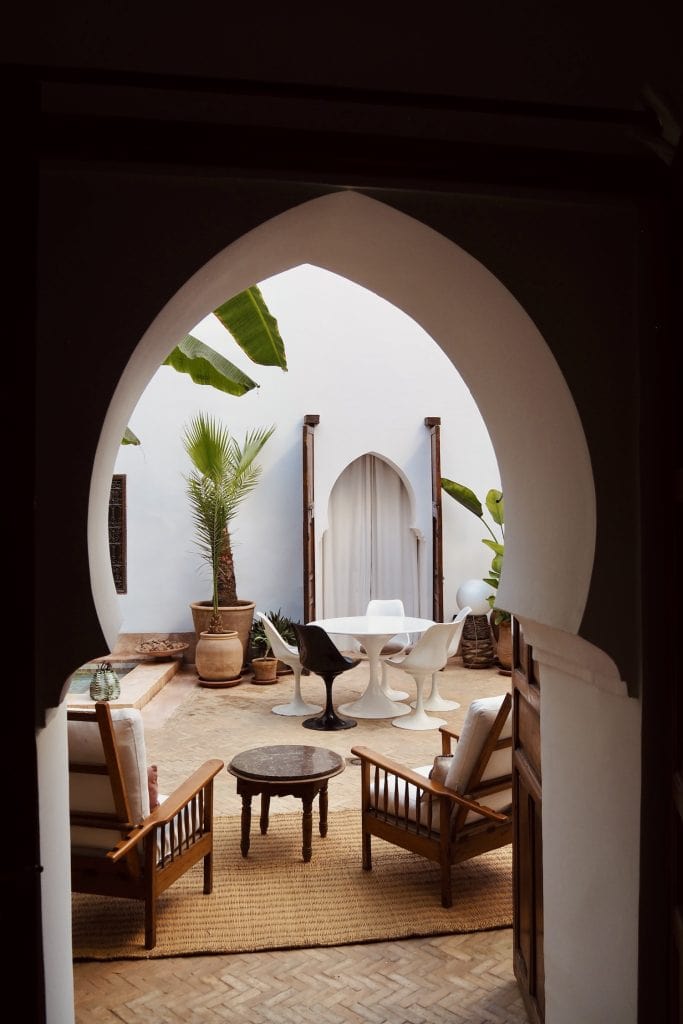
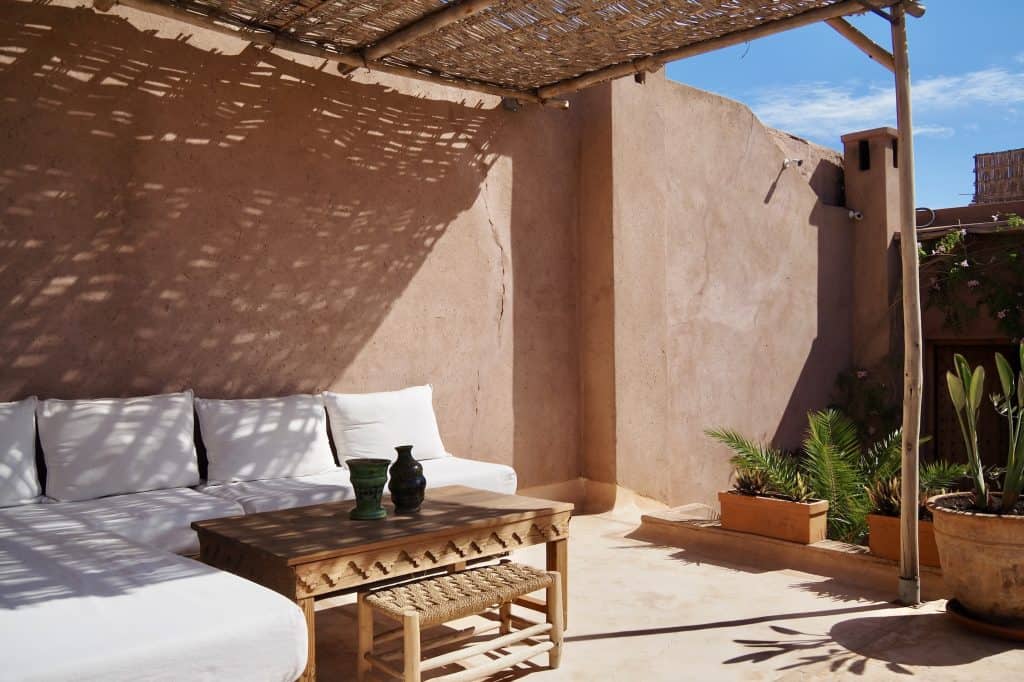
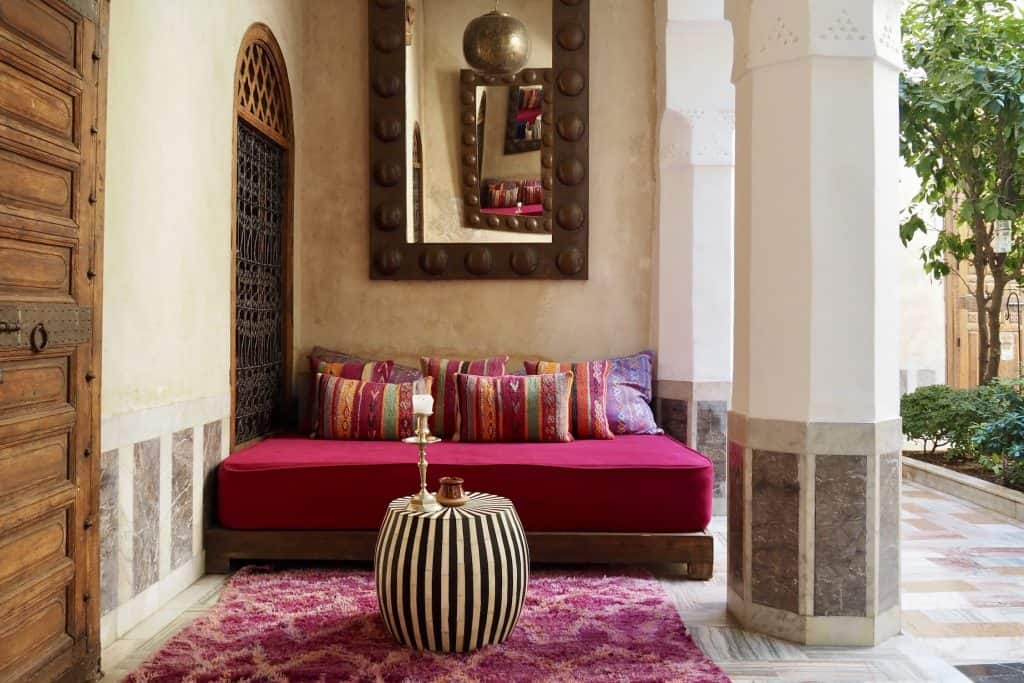
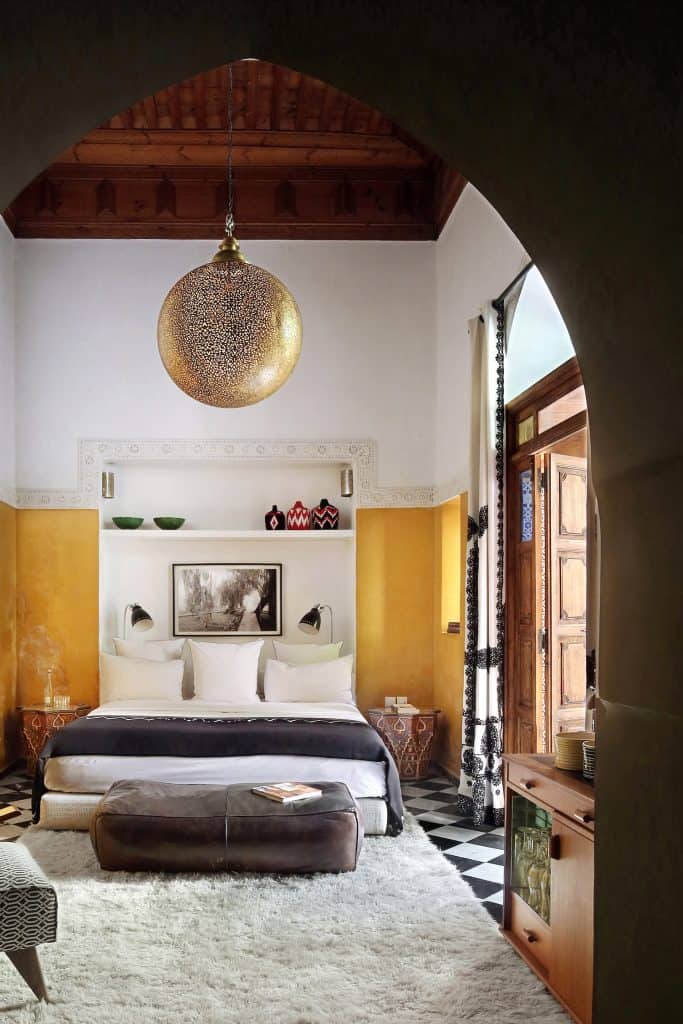
El Fenn.
When the British writer, Gerald Durrell, moved from Bournemouth to Corfu in 1935, he described it as stepping out of a black-and-white film and into colour. For me it was checking into El Fenn. The story of the town’s most exuberant hotel began in 2002, when Vanessa Branson and Howell James bought a crumbling riad and discovered upon signing that it came with four adjoining houses. Too large to be the holiday pad they’d planned, the pair instead opened a six-room guesthouse, with jewel-toned interiors and a party-perfect rooftop, blazing a trail on the Moroccan hotel scene ever since.
Neighbouring houses were bought as they hit the market and today, El Fenn spans 12 interconnecting buildings over two acres, a labyrinth of cool pools, shaded courtyards and sun-dappled terraces on the edge of the Marrakech medina. Forty-one guest rooms go from compact to enormous, in a palette that shifts between sand, charcoal and turmeric, sea green and bubble-gum pink. Magical is the mix of traditional Moroccan elements—green and white zellige, doors and windows in geometric stained glass and rugs from the Middle Atlas—with Bauhaus lamps, fifties Italian armchairs and punchy art.
Trumping the lot is El Fenn’s fabulous roof terrace, home to a swimming pool, restaurant and bar in red stripes and suzani-like patterns (textile designer Madeline Weinrib is also a partner in El Fenn) with bang-on views of Koutoubia Mosque.

EAT/DRINK
Le Marocain.
Between Rachid Agouray’s prowess in the kitchen and the magic of Jacques Garcia’s Orientalist interiors, it’s hard to know what outshines what at Le Marocain. Not to mention the setting, nestled as it is amongst towering palms in the 37-acre garden of La Mamounia, that dazzling grand dame of North African hotels. Either way, if you were only to experience the richness and variety of Moroccan cuisine once in your life, you’d want it to be here. Start with a few of Chef Rachid’s signatures, like the selection of Moroccan salads, tomato tart with sardines marinated in mint oil and the lobster pastilla from Agadir. Move onto John Dory marinated in turmeric (with its long Atlantic coast, the fish in Morocco is excellent) or lamb rack in green tea and sea salt. Rarely is a menu so tantalising, matched by exceptional service and a wine list that reads like a who’s who of world stars. Dress up and allow plenty of time: if ever there was a place to savour each moment in slow motion, it’s Le Marocain.
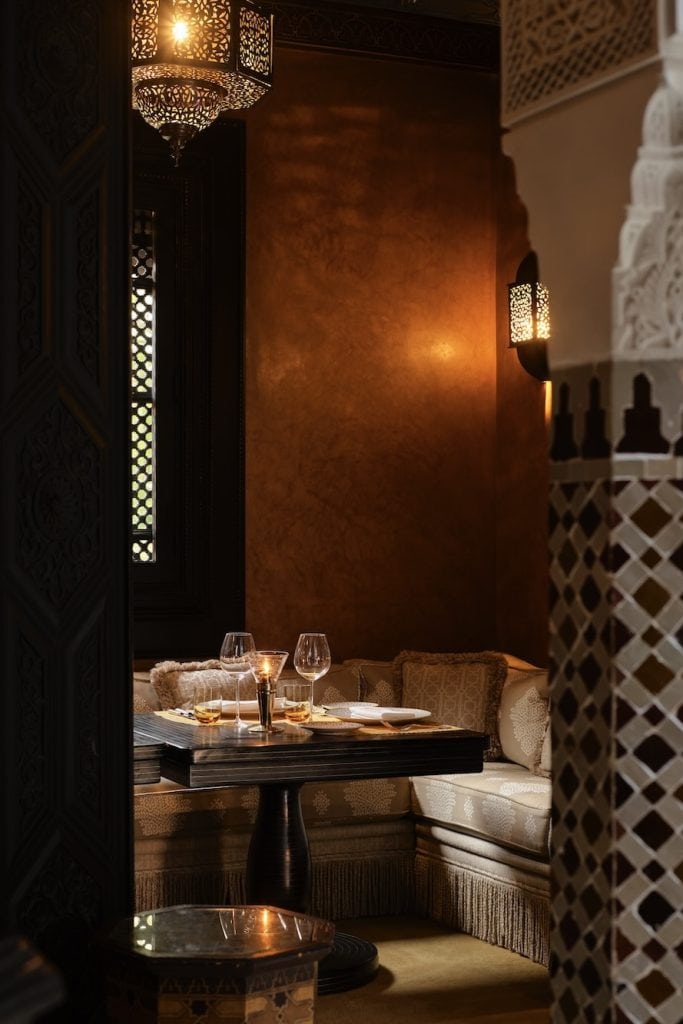
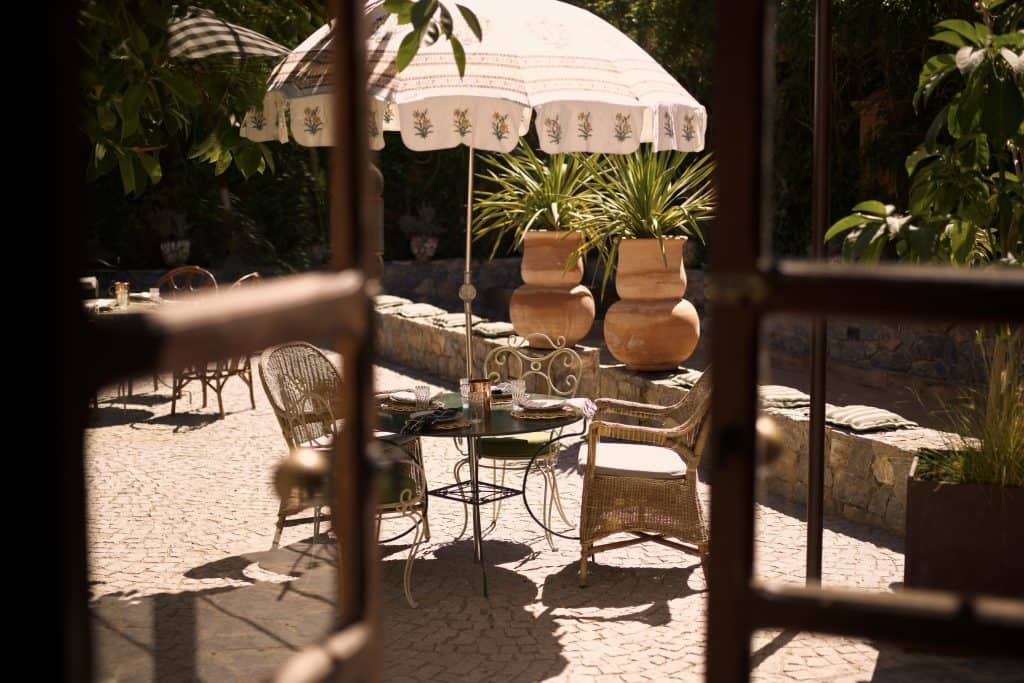
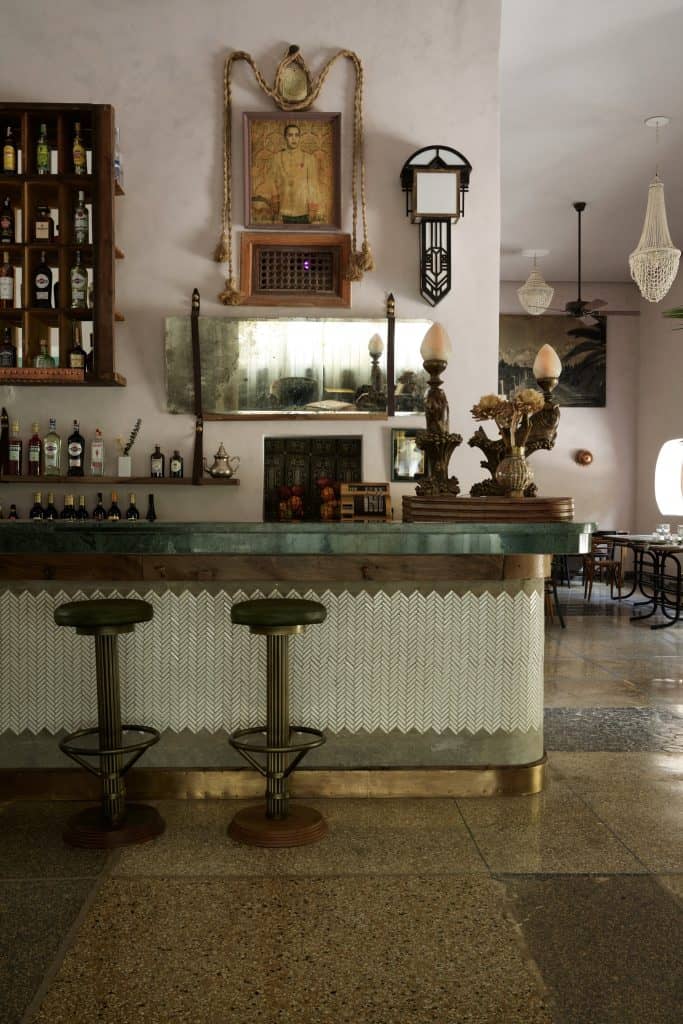
Pétanque Social Club.
A club was established in Gueliz in the 1930’s, where colonials met in a walled garden to play pétanque, a Provencal variation of boules, followed by a pastis at the bar. The area morphed into a red-light district and the club fell into decline, closing out the century as a cheap but cool beer joint where Kamal Laftifi would hang out with friends. A legend on the restaurant scene after opening the game-changing Café des Épices in 2003, Kamal kept his eye on the club over the years, securing it in 2019. A three-year renovation was overseen by Ibiza-based design studio Diego and Alexeja, and Petanque Social Club was born. Everything from the site was repurposed: roof beams were used to construct the bar; old shutters were turned into table tops and existing windows were flipped 90 degrees to allow more light into the interiors. 1970’s armchairs from La Mamounia sit against a wall in dirty chartreuse, hung with vintage photos of the club’s original members. A striking mural by Moroccan artist, Yassine Balbzioui, wraps around the next space. With a menu fusing North Africa and Southern Europe, cocktails like the Sahara Spritz (a take on the Campari Spritz, with saffron) and what might just be the prettiest courtyard in Marrakech, it’s easy to see why Pétanque is the hottest ticket in town. Others include Laftifi’s Le Jardin (a must for lunch in the medina) and the just-opened food-and-art space Dada Marrakech.
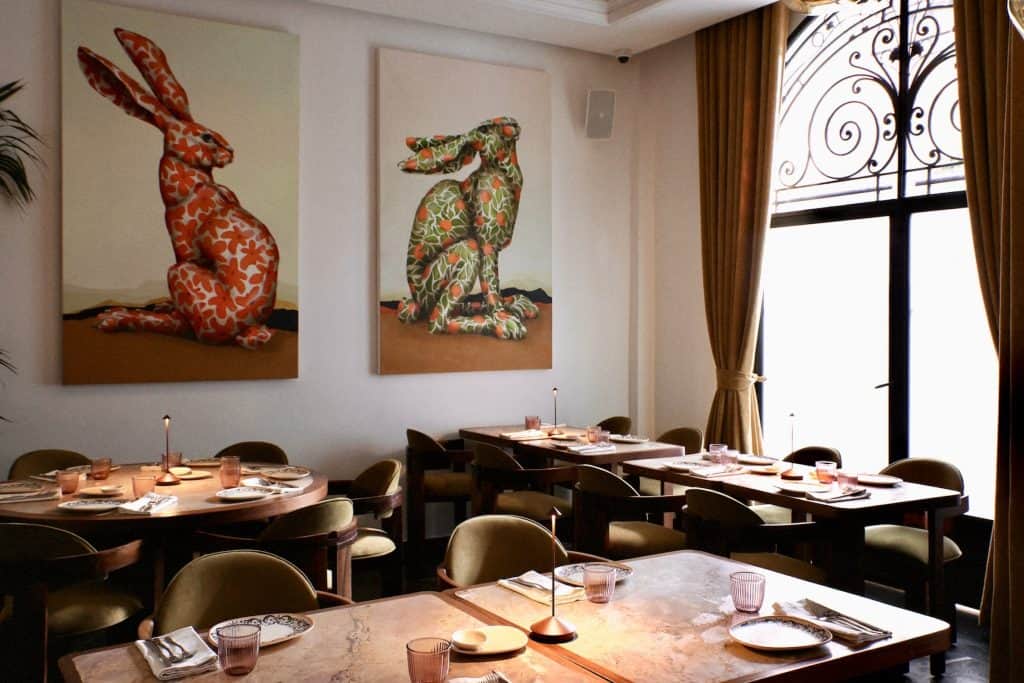
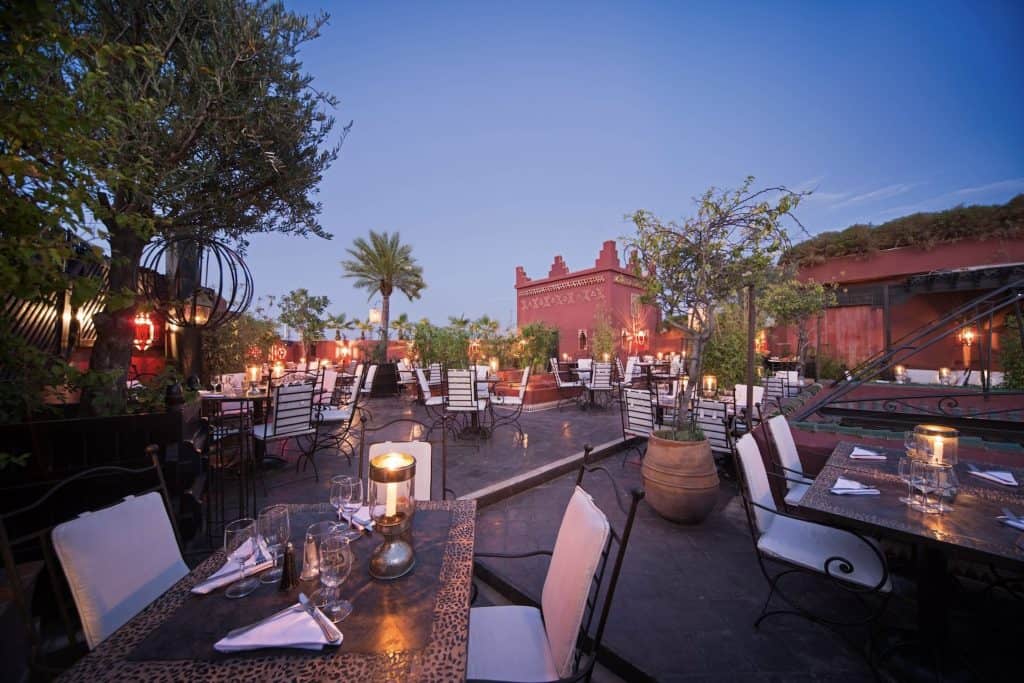
Farmers.
When Moroccan financier Aziz Nahas bought a neglected farm outside of Marrakech 20 years ago, he had no idea how fruitful, literally, his labours would be. From the farm—today producing a wealth of organic produce, doubling as an artists’ residency and animal sanctuary under the banner Farm Slimane—Aziz teamed up with the French restaurateur, Benjamin Pastor. The pair launched a café and farm shop in buzzing Gueliz, followed by the elegant Farmers in September 2024. This place is not to be missed. Chef Driss Aloui’s seasonal plates unite flavours of the ‘Global South’ with the farm’s organic fare (cooked three ways and served with smoky green peperonata and toum, the Farm Chicken was sensational), alongside Canadian sommelier Simone Mérette’s diverse and excellent wine list. Next up from the team is the bar, Napa, and a bookshop focussed on tomes of art and food.
Le Foundouk.
For centuries, Marrakech was an important stop on the trade route between the Mediterranean and Timbuktu. Travellers and their animals would rest at roadside inns known as caravanserai, recharging before or after the schlep across the desert. One such caravanserai is now the restaurant, Le Foundouk. Lovingly restored by owner Frédéric Velissariou, the centuries-old building rises up around a central patio, home to a cocktail bar and dining spaces. The jewel in the crown is the candlelit rooftop, old school with wrought-iron armchairs, olive trees and gorgeous views across the medina. A classic menu traverses Moroccan cuisine with the odd international flourish: monkfish tagine with saffron, fennel, green chermoula and preserved lemon; creamy polenta with porcini mushrooms; saffron crème brulée.
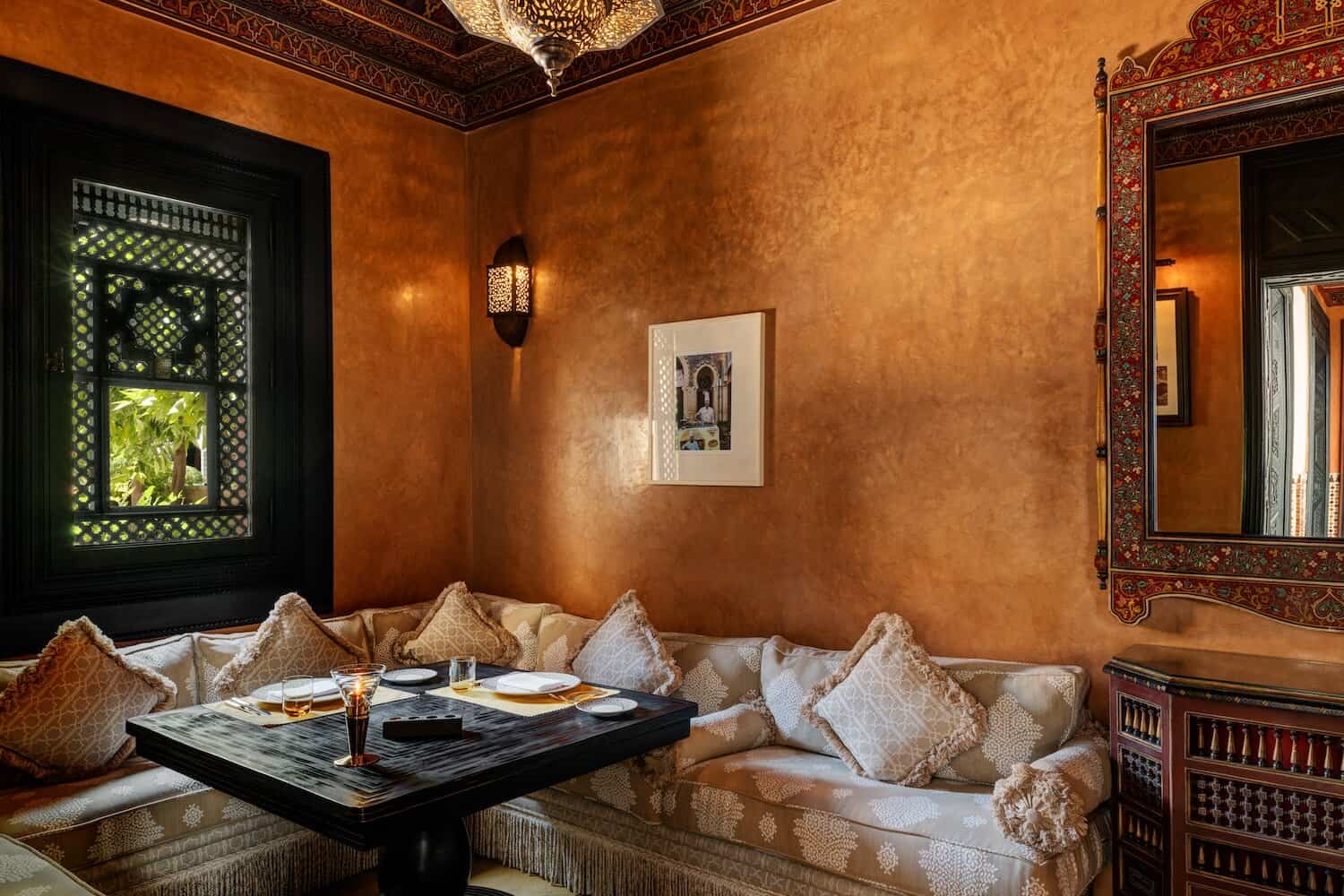
+61.
Cassandra Karinski cut her hospitality teeth working for Sydney legends Bill Granger, Kylie Kwong and Tetsuya Wakuda before moving to Marrakech in 2005. While the plan was always to open a restaurant, creative projects from rugs to kaftans, styling and writing got in the way, and it wasn’t until 2018, when friend Sebastian de Gzell said, “you’ve got to do this,” that +61 was born. With the dialling code as its name, the concept is simple: uncomplicated fare reflecting the diverse, laid-back nature of Australia. And like Australia, the menu takes cues from across the globe, with hearty schnitzel and steak sandwiches at lunch, tuna tartare and mushroom gyoza at dinner. The setting is gorgeous, relaxed but sophisticated with friendly, unpretentious service—a little bit of Bills in downtown Gueliz.
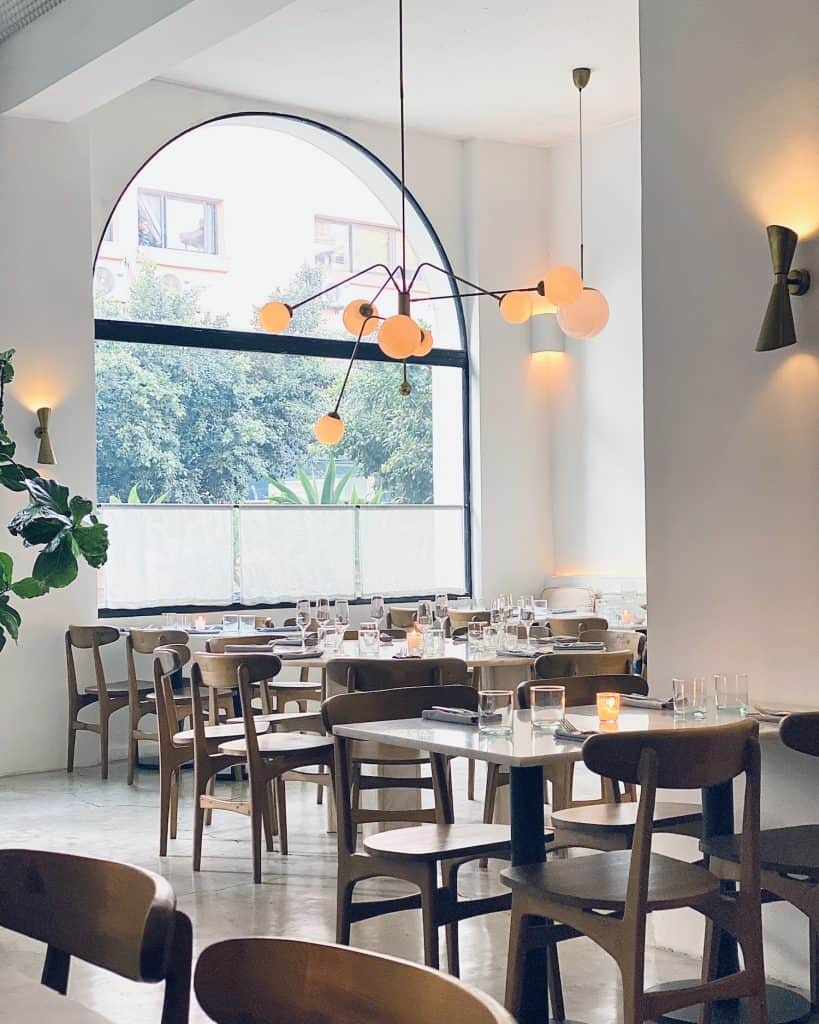

Kabana.
Compared to their sky-scraping counterparts in megacities across the globe, rooftop bars in Marrakech channel a different spirit. Closer to earth and more bohemian, low-rise vistas meld blocky buildings into a sea of pink at sunset, all the way to the Atlas Mountains, broken by the profiles of date palms, satellite dishes and the odd washing line. With its knockout view of the lot, including the minaret of the magnificent Koutoubia Mosque, it doesn’t get much better than Kabana. Go for a drink, stay for dinner. Banging food, cocktails and ambiance—think cool tunes, cane chairs and hanging lanterns, hot waiters squeezing past—make Kabana the hottest rooftop bar in Marrakech.
DO.
Shop.
From scented oils to amber, ceramics and Tuareg tent pegs, Fez hats, kaftans and custom-made shirts, artisanry is alive and well in Marrakech. The setting and the ingenuity of the locals—a synthesis of Berber, Mediterranean, African and Andalusian artistic traditions—make shopping here a unique experience. Hit the souk for tribal jewellery, painted cedarwood chests, alabaster vases and rustic, wood-fired pottery like the emerald-green pieces from Tamegroute.
Amongst the labyrinth of vendors, you’ll also find smart storefronts. Barbara at Boutique 170 does beautiful linen clothing (all made in Marrakech) alongside books and art, while Hassan Hajjaj’s emporium Riad Yima has a Warhol-worthy mix of objects, fashion and the artist’s own photographic work.
Head to Studio LID in Sidi Ghanem for the finest Berber rugs—vintage, new and custom made, alongside gorgeous Tuareg mats from Mauritania (pictured). The Lamdaghiri family have been in the business since 1940 and know their stuff better than most, working with more than 200 rural artisan weavers. On the way back to the riad, stop at concept store MORO for cool clothing, homewares and a bottle of Hashish parfum from in-house label The Moroccans—a mix of anise, cinnamon, cannabis ruderalis and amber.
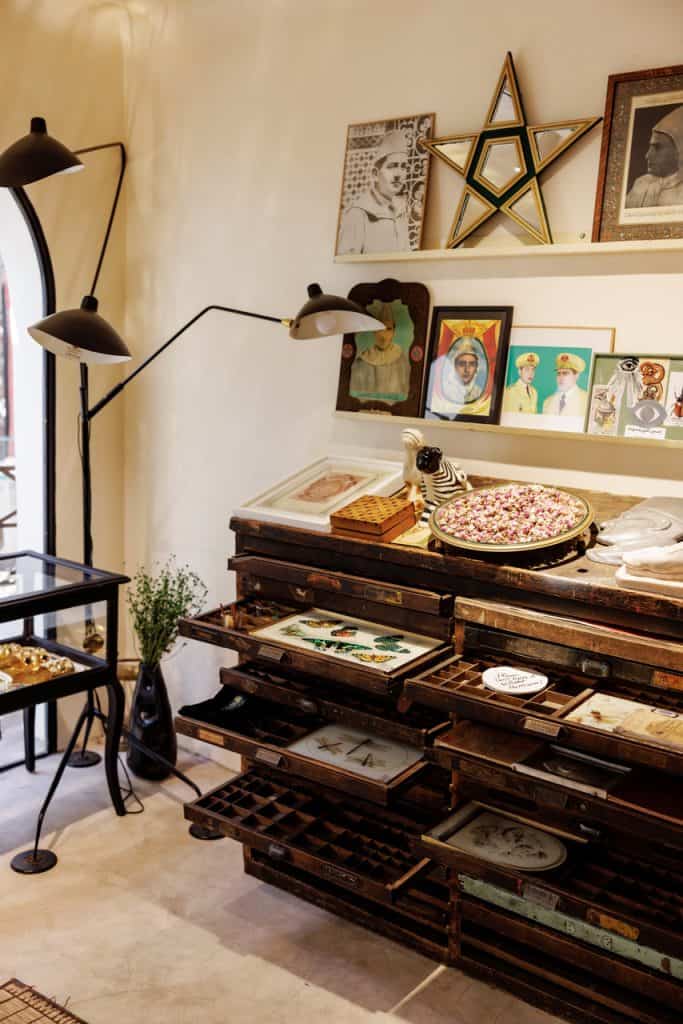
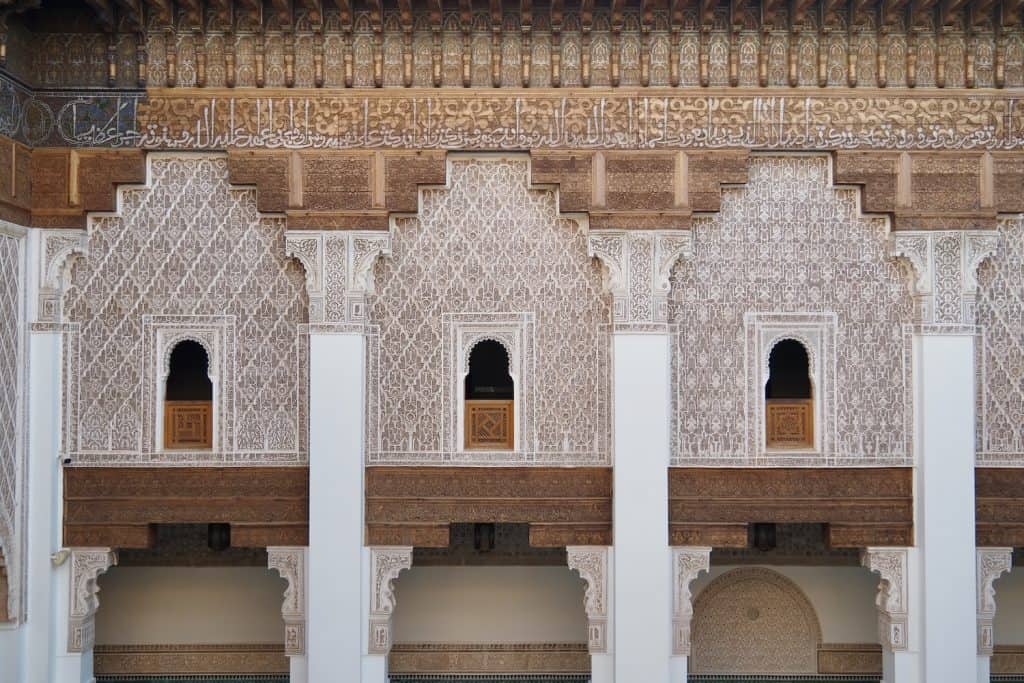
Madrassa Ben Youssef.
Once the largest Islamic school in the Maghreb—Arab North Africa—the Madrasa Ben Youssef is to Marrakech what the duomo is to Florence: a masterpiece of religious architecture and the city’s cultural heart. Commissioned in 1564 by the Saadian sultan, Abdallah al-Ghalib, the complex centres around an elegantly proportioned courtyard stacked with sculpted plaster, zellige tiles and blocks of cedarwood carved with calligraphy, a reflective pool at the centre of its white marble floor. A labyrinth of mini riads wrap around it, home to, during the madrasa’s heyday, 900 students studying the Koran. Go first thing in the morning or at the end of the day to enjoy thinner crowds and lovely soft light.
Le Jardin Secret.
Set A grand mansion was constructed over the ruins of a Saadian era palace in the mid-19th century, one of the largest in Marrakech at the time. Over the years it passed between various Caïds, or tribal leaders—one, according to local legend, was even killed off with poison tea. Like many of the city’s historic homes, it was semi-abandoned in the mid-20th century and suffered decades of neglect. Then came Lauro Milan and Sante Giovanni Albonetti of Cafe Arabe, restoring the property and opening its doors to the public for the first time in 2016 as Le Jardin Secret. With two large courtyards, it’s the medina’s most verdant oasis: a smaller space packed with exotic plantings and a larger, fourfold Islamic garden divided by green-tiled rills, conceived by British landscape architect Tom Stuart Smith. Climb the 17-metre belvedere—virtually the only structure of its kind left in Marrakech—for spectacular views across the city’s rooftops, all the way to the Atlas.

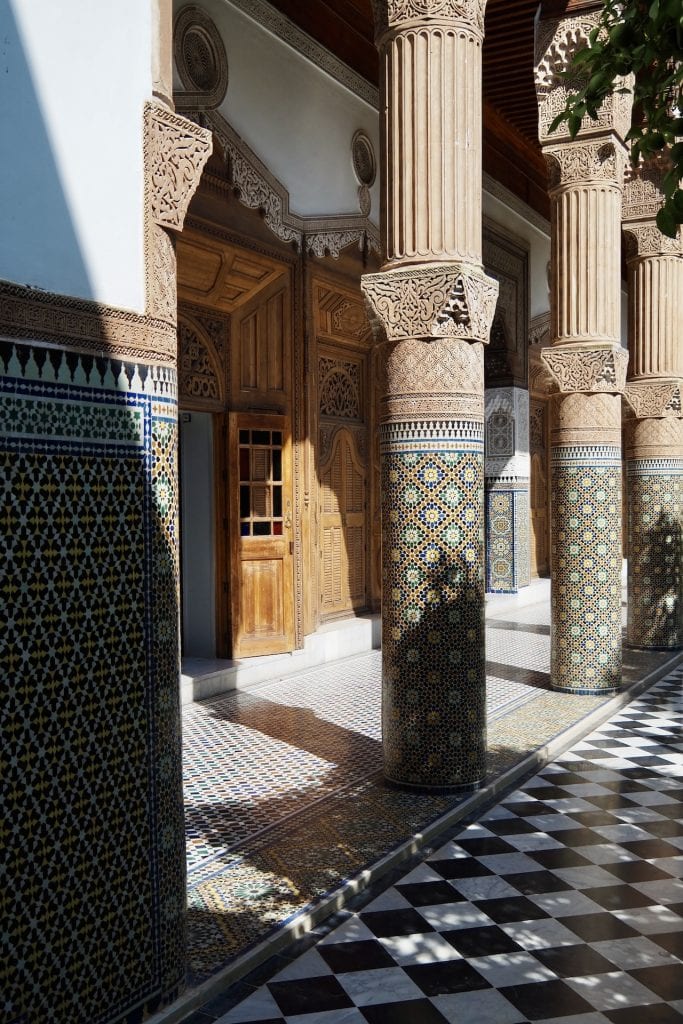
Dar El Bacha.
As Pasha of Marrakech, Thami El Glaoui was one of the most powerful men in Morocco during the French Protectorate, wielding political and social might from his home, Dar El Bacha. Built in 1910, the palatial compound showcases Moroccan craftsmanship at its finest—zellige tiles, intricate plasterwork and carved and painted wooden ceilings—a meeting place for dignitaries and artists alike. Falling into disrepair after El Glaoui’s death in 1956, Dar El Bacha has been brought back to life as the Museum of Confluences, home to a small but exquisite collection of objects celebrating the diversity of Moroccan culture, alongside one of the city’s most photogenic cafes, Bacha Coffee.
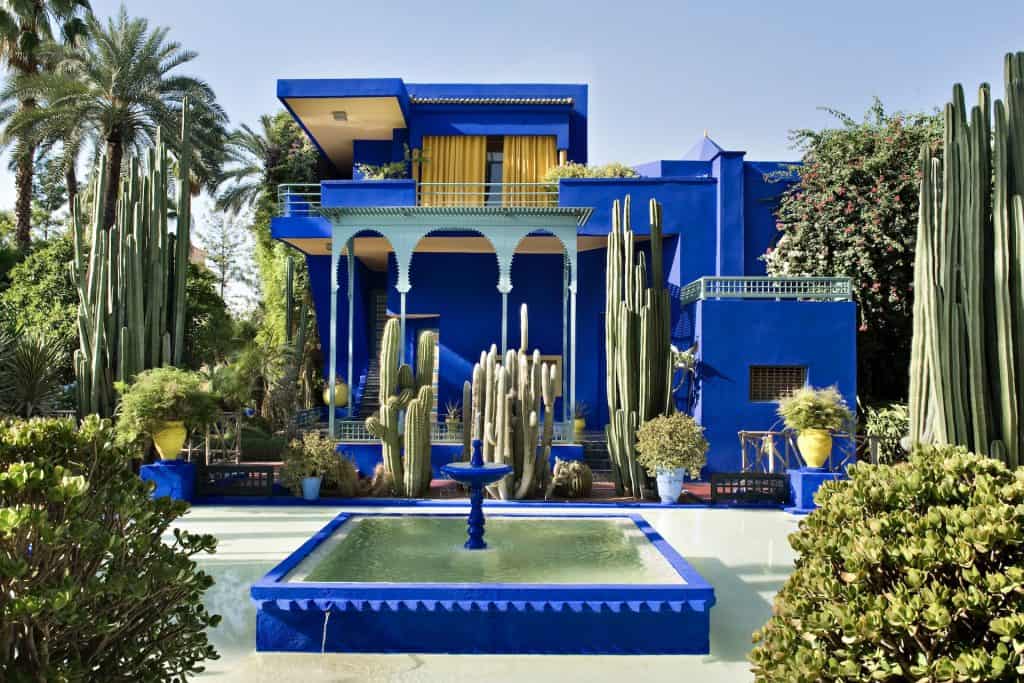
Jardin Majorelle/Musée Yves Saint Laurent.
“Morocco was where we were happiest,” Pierre Bergé once said of his life with Yves Saint Laurent. The couple arrived in Marrakech in 1966, staying at La Mamounia before acquiring a house in the medina, followed by a larger house in Gueliz not far from the Jardin Majorelle. Conceived by French painter Jacques Majorelle in the 1930’s, the Jardin comprised four acres of cacti, palms and other eccentric plantings (growing to ten acres as Majorelle purchased adjoining parcels of land), and a Cubist villa he painted in a vibrant, now-iconic shade of blue. In 1980—Majorelle long gone and the real-estate developers circling—Bergé and Saint Laurent purchased the property to save it from demolition. Like the artist before them, the couple kept a chunk of the garden open to the public and today, the Jardin Majorelle is the most visited site in Morocco. Majorelle’s former studio is now the Musée Berbère, home to the couple’s museum-grade collection of Berber artifacts. Completing the trifecta is Musée Yves Saint Laurent—a red-brick pile designed by Studio KO, home to permanent displays of Saint Laurent’s designs—just across the road.


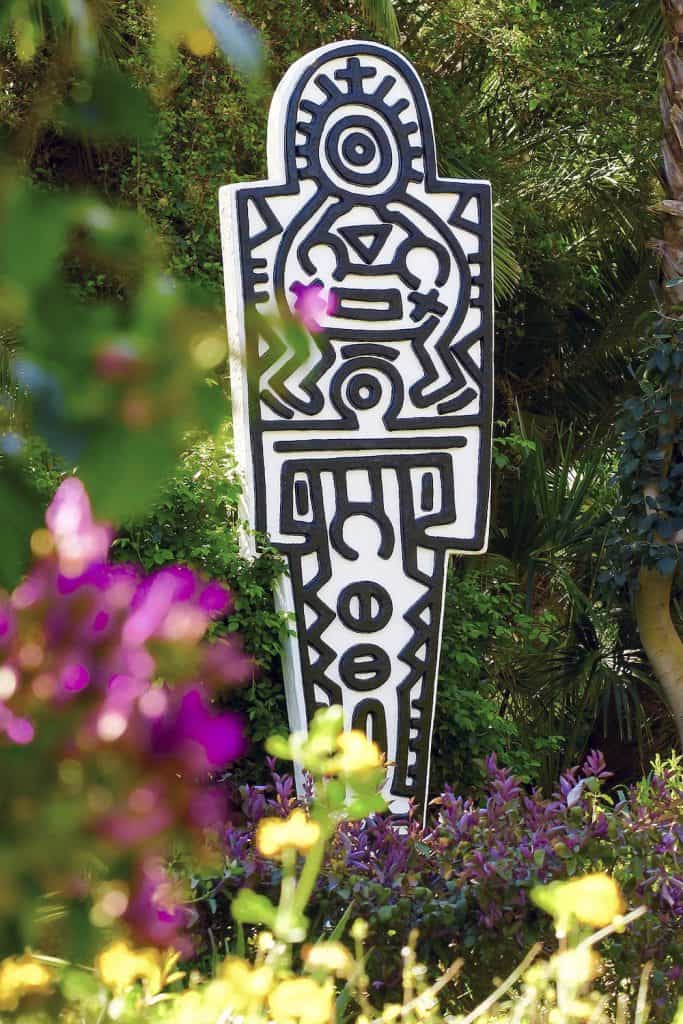
Ourika Valley.
When the medina has you spinning, head to the Ourika Valley. Winding along a river in the High Atlas, the valley’s remote feel and pristine vistas belie its proximity to Marrakech, 30km away. Stop halfway at Anima Garden, where Austrian multi-media artist André Heller has crafted a place of great imagination and beauty: an outdoor museum, home to more than 250 types of plants, colourful follies and sculptures by Keith Haring, Alexander Calder and Pablo Picasso. A giant African head by Heller himself, based on the colourful beaded ones for sale in the souk, sprays a mist of water from its mouth—bliss on a hot day. Continue to Kasbah Bab Ourika, a fort-like hotel in rammed earth on the edge of a rustic village, for lunch on the terrace—think quinoa salad with avocado and argan oil or the tomato and tuna mille feuille—jaw-dropping views all around.
From a story originally published in Vogue Living.